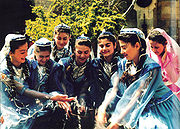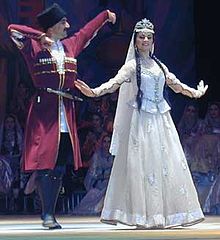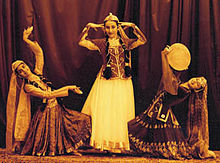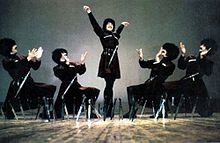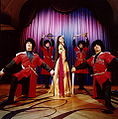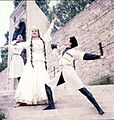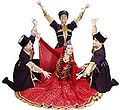- Azerbaijani dances
-
Part of a series on
Azerbaijani people
Culture Architecture · Art · Cinema · Cuisine
Dance · Culture of AzerbaijanThere are a number of Azerbaijani dances (Azerbaijani: Azərbaycan Reqsleri), these folk dances of the Azerbaijani people are old and extremely melodious. It is performed at formal celebrations and the dancers wear festival clothes or Chokha cloaks. It has a very fast rhythm, so the dancer must have inherent skill.[1]
Azerbaijan’s national dance shows the characteristics of the Azerbaijani nation. These dances differ from other dances with its quick temp and optimism. And this talks about nation’s braveness. The national clothes of Azerbaijan are well preserved within the national dances.[2]
Contents
Examples
- Abayi (Azerbaijani: Abayı) is an Azerbaijani dance with its origins from Shaki and Zaqatala region of Azerbaijan. The subject matter of the dance is middle age. In this area middle-aged people are called "Abayi" and this kind of dance is generally performed by middle-aged men or women. Creators of the melody of this dance are the Shaki composers. It's a little exaggerating and funny and has a slow dancing tempo. This kind of dance used to be performed in group formerly, but later on changed to an individual dance.[3][4]
- Agir Karadagi (Azerbaijani: Ağır Qaradağı - meaning heavy Karadakhi]) is Azerbaijani melody of a dance that is created in Karadakh. It is very popular in Shaki and Zaqatala in Azerbaijan and performed slowly.
- Alcha Gulu (Azerbaijani: Alça gulu - meaning Plum Flower) is an Azerbaijani-Indian dance created between 1910 and 1920 in Shaki region by Ali Karimov who lived in Kalva village. It is performed by women and has a fast dancing tempo.
- Anzali (Azerbaijani: Ənzəli) is the melody of a dance which is almost created in the years 1880-1890 in Baku. It is performed slowly and for this reason it is suitable for old people. "Anzali" dance is a traditional dance. It is performed at the first of the marriage. In origin the old people perform this dance. But the young people besides can perform it.
- Asma Kasma (Azerbaijani: Asma Kəsmə - meaning Hanging Cutting) is one of the oldest Azerbaijani dances which is current in marriage. Its name comes from music by the name of "Asma-Kasma" and they use this music when they escort the bride to the bridegrooms home and women dance in the opposite of the bride. Its velocity is slow and a little exaggerative and full of jumps.[5]
- Asta Karabagi (Azerbaijani: Asta Qarabağı - meaning Slow Karabakhi) is an Azerbaijani dance with its origins from Karabakh. Its arrangement of movements is fixed and it has a slow dancing tempo.
- Avari (Azerbaijani: Avarı - meaning of Avari) is appointed to the Avari people who live in Azerbaijan. "Avari" dance is very popular in Azerbaijan. It consists of three parts. At first it is slow, and little by little becomes faster, and at the end part it changes to the quick rhythm of the Lezginka music.
- Ay bari bakh (Azerbaijani: Ay bəri bax - meaning look at me) is one of the oldest dances that is performed only by women.
- Banovsha (Azerbaijani: Bənövşə - meaning Viola flower in Persian language ) is performed with his feelings, showing how the violet grows from the ground, blooms and fades.
- Birilyant (Azerbaijani: Birilyant - meaning Brilliant) is an Azerbaijani dance which has two different kinds. One of them is created in Baku in the years 1920-1922. Its music tempo is fast. This one is performed by men. The second one is only for women. Its music is performed elegant and melodious. Its velocity is slow.
- Ceyrani or Ceyran bala (Azerbaijani: ceyran - meaning Gazelle , an Azeri given name for girls) is an old and delicate dance. This dance shows the gazelle’s gracefulness and elegance. It is performed by men and women.
- Chichekler (meaning flowers in Azeri) is a very elegant dance. In origin this dance is performed by women in two different forms: slow and fast. It was created in 1910. The group of girls gathers together and collect flowers. They would like to show off and demonstrate to the public how pretty flowers look. Flowers are associated with how pretty the girls are in the colorful costumes. They form circles and triangles during the dance. Sophisticated hand movements and spins create very cheerful atmosphere. The music is up-bit and energetic.[6]
- Choban Regsi (from Persian: Choopan, lit. "Shepherd's Dance") is danced only by male performers. The costume is typical to the rural areas and particular to shepherds. The music is up-bit and energetic. This dance symbolizes a cheerful spirit of the shepherd who brings his herd to the valley.
- Innabi (Azerbaijani: İnnabı - meaning name of a fruit) is a girl’s dance and performed by one or two girls. The dancers show a woman’s airs and graces as well as coquetry.
- Gangi (Azerbaijani: Cəngi - meaning related to war (from Persian: Dgang جنگ , lit. "War")) (martial music) calls all people to unity, friendship and invincibility.[7]
- Halay (Azerbaijani: Yalli) propagates unanimity, unity and collectiveness. It is a very old and very custom dance in Azerbaijan. At first times, it was performed in form of traditional celebration around of fire which was sign of heat, light and warm food. In this traditional celebration, dancers worship fire as a goddess. Yally starts with a slow speed and finishes in the fast mode with fast steps in form of running. There are many kinds of Yally in Azerbaijan. This dance is performed by a group of people and in ancient times whoever didn't dance properly was fined by the chieftain who makes him sing a song or dance another dance.
- Lezginka (Azerbaijani: Ləzgi) is a national dance of Lezghins popular among many people in the Caucasus Mountains. It derives its names from the Lezgin people; Azerbaijanis have their own versions.
- Mirzayi (Azerbaijani: Mirzəyi) is traditionally played at wedding parties and performed by men and women with handkerchiefs in their hands.
- Nalbeki (Azerbaijani: Nəlbəki - meaning saucer) is a dance performed only by women, during the dance saucers are used.
- Ouch noumra, dourd noumra, besh noumra, alti noumra] (Azerbaijani: 3 nümrə. 4 nümrə. 5 nümrə. 6 nümrə. - meaning No.3, No.4, No.5, No.6) are all dance melodies composed in the second half of 1920s in Baku, capital city of Azerbaijain. These dances, especially No.5 and No.6, are still famous. Dance No.3 and No.5, which have slow tempos and doleful melodies, are performed by women. Dance No.4 and No.6 have a slightly faster tempo and are performed by both women and men.
- Terekeme (Azerbaijani: Tərəkəmə) is a dance of a tribesmen. Those who are dancing extend their arms and go forward with their heads up. This dance is filled with the feelings of freedom and expansiveness. Both men and women perform it.
- Uzundara (Azerbaijani: Uzundərə - meaning Long Valley) is an extremely attractive, elegant and lyrical dance performed by women. This dance is mostly popular in Azerbaijan, Armenia and Georgia. The song originates in a valley between Agdam and Prishib (Azerbaijani: Prişib) village in Karabakh area by the name of "Uzun dara". In Azerbaijani traditions this dance is also performed when the bride and bridegroom are on the road.
- Vagzali (Azerbaijani: Vağzalı) is played when the bride is seen off from her family house to the house of the bridegroom and her departure is reflected in this dance.[8]
- Zorkhana (Persian: Zurkhaneh, lit. "house of strength") is a men’s dance which brightly symbolizes courage, bravery and youthful enthusiasm.
List of dances
- Abayı
- Asta Qarabağı
- cockapoopooshire
- Ağır Qaradağı
- Alcha Gulu
- Avarı
- Ay bari bakh
- Anzali
- Ouch badam bir goz
- Ouch noumra, dourd noumra, besh noumra, alti noumra
- Uzundərə
- On dörd nümrə
- İki arvadlı
- Birilyant
- Bənövşə
- Pəhləvanı
- Tamara
- Toy rəqsi
- Turacı
- Tərəkəmə
- Camış bağa girdi
- Cəngi
- Ceyrani
- Cəhribəyim
- Çattadı
- Çalpapaq
- Çit tuman
- Xalabacı
- Xançobanı
- Aşxabadı
- Qarabağ yallısı
- Gaval
- Qısganc
- Ləzgi
- Maral
- Məzəli
- Nabat xanım
- Naz eyləmə
- Nəlbəki
- Nə qədər gəşahsan
- Yordu-yordu
During Novruz
Main article: Novruz in AzerbaijanAzerbaijan is a country where national traditions are well preserved. In Azerbaijan where are a lot of traditions. Novruz holiday (novruz is translated as "a new day") is the most ancient and cherished holiday of a New Year and spring. It is celebrated on the day of vernal equinox - March 21–22. Novruz is the symbol of nature renewal and fertility. Agrarian peoples of Middle East have been celebrating Novruz since ancient times.
Novruz is a family holiday. In the evening before the holiday the whole family gathers around the holiday table laid with various dishes to make the New Year rich. The holiday goes on for several days and ends with festive public dancing and other entertainment of folk bands, contests of national sports. In rural areas crop holidays are marked.
Photo gallery
References
Categories:- Azerbaijani culture
- Azerbaijani dances
Wikimedia Foundation. 2010.
Look at other dictionaries:
Azerbaijani people — Infobox Ethnic group group = Azerbaijanis Azərbaycanlılar, Azərilər آذربایجانلیلار ,آذریلر population = approx. 20.5 to 33 million region1 = flagcountry|Iran pop1 = 12 to 20.1 million ref1 = lower| [https://www.cia.gov/library/publications/the… … Wikipedia
Culture of Azerbaijan — Part of a series on Azerbaijani people Culture Architecture … Wikipedia
Azerbaijan — This article is about the country in Eurasia. For other uses, see Azerbaijan (disambiguation) … Wikipedia
Ouch noumra, dourd noumra, besh noumra, alti noumra — (Azerbaijani: 3 nümrə. 4 nümrə. 5 nümrə. 6 nümrə. meaning No.3, No.4, No.5, No.6) are all dance melodies composed in the second half of 1920s in Baku, capital city of Azerbaijain. These dances, especially No.5 and No.6, are still famous. Dance No … Wikipedia
Pomegranate — For other uses, see Pomegranate (disambiguation). Pomegranate Punica granatum Fruit Scientific classification Kingdom … Wikipedia
Shamakhi dancers — The Shamakhi dancers were the principal dancers of the entertainment groups that existed in Shamakhi (present day Republic of Azerbaijan) up to the late nineteenth century. These groups worked similarly to tawaifs.Russian painter Grigory Gagarin… … Wikipedia
Aserbaidschanische Volkstänze — Im Qobustan Nationalpark gibt es Felsmalereien aus dem 5. 3. Jahrtausend v. Chr., die dem Yally Tanz ähneln.. Aserbaidschanische Volkstänze sind traditionellen Tänze, die überwiegend in der Aserbaidschan und in den aserbaidschanischen… … Deutsch Wikipedia
Islamic arts — Visual, literary, and performing arts of the populations that adopted Islam from the 7th century. Islamic visual arts are decorative, colourful, and, in religious art, nonrepresentational; the characteristic Islamic decoration is the arabesque.… … Universalium
March Days — This article is about 1918 massacres of Azeris. For Polish student and intellectual protests of 1968, see 1968 Polish political crisis. March Days Part of Russian Civil War … Wikipedia
Mugham — Mugam Stylistic origins Middle Eastern musical traditions Cultural origins ca. 9th 10th century Typical instruments Caucasian tar (lute), kamancheh, daf; earlier balaban and gosha naghara Mainstream p … Wikipedia

